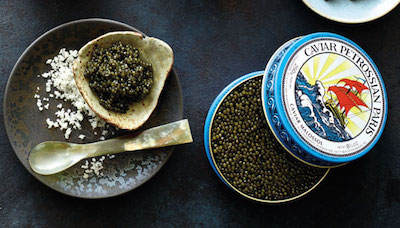Petrossian: Historic Russian Product with A Timeless Appeal

When I test drove a marvelous vintage Porsche last month I had no idea I would soon be tasting caviar at about the same price. Among the most famous and expensive of the precious eggs, Almas (“diamond” in Russian) costs about the same price pound per pound at $25,000 for 1 kg or $700 per ounce.
Though caviar is simply sieved and lightly salted fish roe, only premium sturgeon roe is considered “true” caviar. Oddly enough, this heavenly and precious treasure comes from a fish with a face only a gourmet could love. Toothless, soft and cartilaginous, it is one of the few surviving bony fish to retain its prehistoric appearance with distinctive long bony plates on the outside and no bones in the flesh.
There are twenty-four existing sturgeon species worldwide. Five of them live in the Caspian Sea, and three of them supply the caviar for 90 percent of the world’s production.
The names are magical: prized Beluga, incomparable Osetra, and the exquisite Sevruga. The older the fish, the lighter the roe is in color – and the more valuable. Also, the larger the eggs, the more expensive the caviar will be with the intensified, increased volume of taste.
There is no better way to learn about caviar than while experience it at the famed Petrossian store and restaurant that retains its old-world charm even with isleek new counters and modern, airy interior.
“The pale silver-gray Beluga caviar is esteemed for its soft, extremely large (pea-size) eggs and extremely thin membranes,” we were told. The better to taste you, my dear. “It nearly became extinct by the end of the last century that this past year, so sadly, it has been banned from being imported into the U.S.”
But not to worry. Other imports, as well as a newer domestic sturgeon are available. With darker and smaller eggs, Ossetra is slightly smaller and firmer in texture than the Beluga. Dark grey-brown and sometimes even golden, its tender walnut- flavour makes it a highly demanded delicacy.
For eating caviar straight out of the jar or tin, figure at least 15 to 30grams per person.One serving of Royal Ossetra costs almost $400; to feed eight generously with Tsaw Imperial Ossetra will set you back close to $4000. And not to worry, there are plenty of takers. In fact, customers who come in almost daily. And there are a few celebrities who do just that on a whim.
Tasting the Osetra the classic way on blini’s and then on the top of my hand between the thumb and forefinger was a new sensation. As instructed, I let the cavier melt in my mouth, savoring the nutty and buttery texture and taste until it was gone.
Highly valued for its incomparable bright, robust flavor and rich aroma, next came the Sevruga from a racy, slim fish ($268-$2700). The smaller eggs range in color from dark to light gray. Harvested just as the sturgeon peaked at maturity, the briny notes of the Sevruga are restrained and the texture is velvety; close your eyes as the rich eggs melt and you really are experiencing a perfect day at the beach.
Alverta Cavier ($163 to $1890) was next. This delectable domestic, farm-raised caviar developed over the last decade in the Sacramento area has a much lighter though a buttery nutty, smooth flavor.
“Domestic has short-lived bursts of flavor while imported eggs explode with a nutty, buttery flavor that lingers on and on,” was our opinion, though we feel it is really “a matter of personal taste.”
Sterling spent entire decade of no profits and a lot of hard work to perfect the eco-friendly, sustainable fashioned harvesting and processing.
“Caviar is best when it’s served simply, “ he said, though it must be kept cold. Caviar should always be serving using nonmetallic utensils to avoid a metallic taste, preferably on elegant small mother of pearl, shell or bone spoons.
Traditionally, caviar served on toast points or buckwheat pancakes “blinis” can be topped with crème fraiche, sour cream, finely chopped red onion, chopped boiled egg, capers or chives. Dry Champagne or ice cold Vodka, sipped slowly, is the only acceptable drink.
Tins of Almas were once reserved for Russian czars. When the Czars were “made to disappear during the 1917 revolution,” Jordan told us, ‘White” Russians’ carried this precious cargo to Paris and started a craze.” “No one could imagine the international fame of the Petrossian brothers who pioneered the first caviar Boutique and Restaurant in 1920 while studying law and medicine.”
Today, U.S. caviar consumers alone are responsible for 60 percent of legal worldwide caviar imports with an estimated value of over $100 million. And don’t forget the additional illegal trade – estimated at $500 million. Eat your heart out, Porsche.

 Gerry Furth-Sides
Gerry Furth-Sides  Barbara Hansen
Barbara Hansen  Chef-owner Alain Cohen
Chef-owner Alain Cohen  Roberta Deen
Roberta Deen  Jose Martinez
Jose Martinez  Nivedita Basu
Nivedita Basu